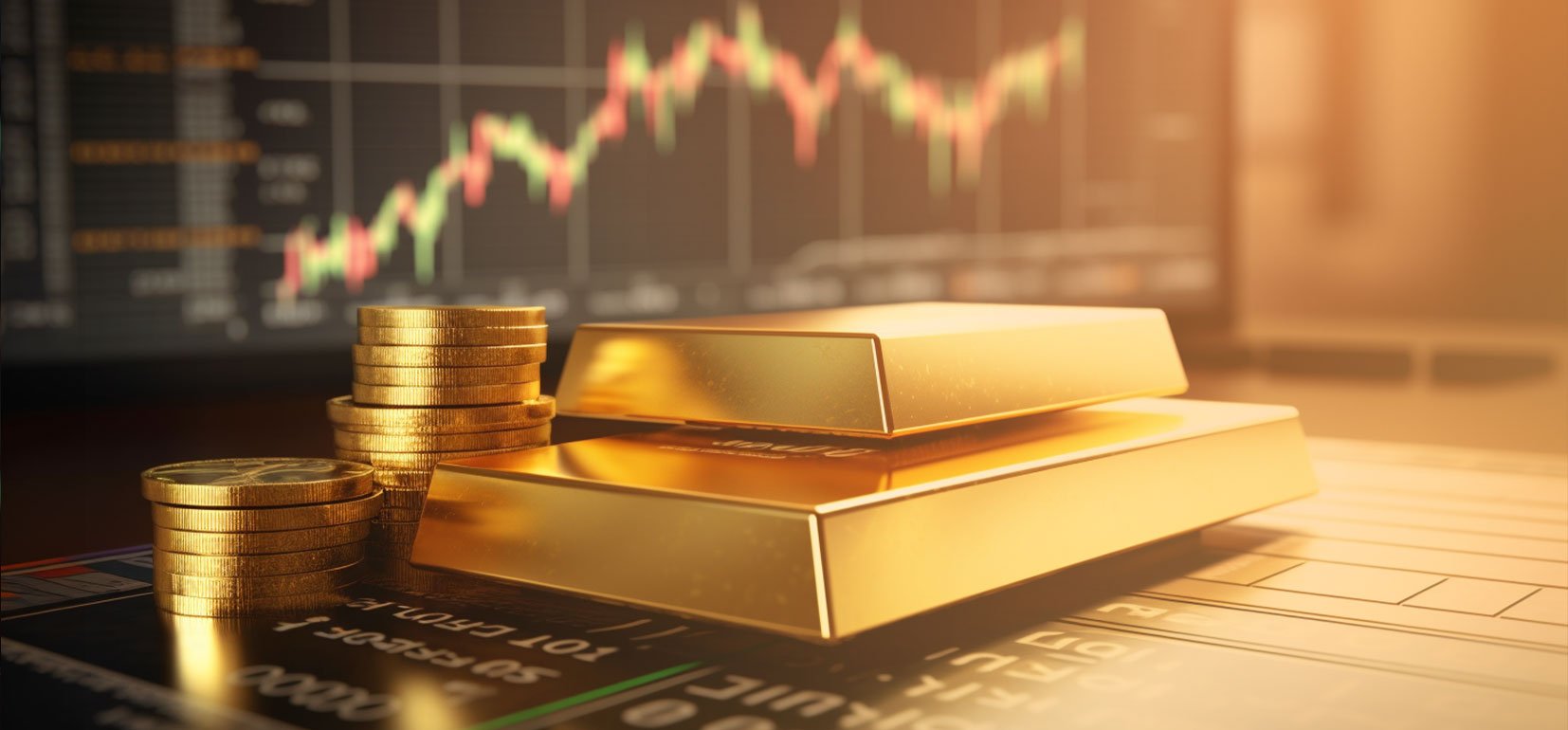1. Understanding Gold as a Trading Asset
Gold, universally recognized as a symbol of wealth and stability, has been a highly coveted commodity for centuries. However, in the realm of trading, it is more than just a shiny metal – it’s a valuable trading asset with unique characteristics that set it apart from traditional stocks and bonds.
Trading gold offers a plethora of advantages. Firstly, it’s a hedge against inflation. When inflation rises, the value of currency falls, but the value of gold often increases. This makes gold a safe haven for investors during economic downturns and periods of high inflation.
Secondly, gold is a diversifier. It has a negative correlation with stocks and bonds, meaning when they fall, gold often rises. This makes it an excellent tool for portfolio diversification, helping to spread risk and potentially enhance returns.
Thirdly, gold is a universal currency. Unlike country-specific currencies, gold is universally accepted and its value remains relatively stable regardless of geopolitical events or changes in currency exchange rates.
However, trading gold is not without its challenges. The price of gold can be volatile, influenced by factors such as geopolitical events, central bank policies, and market sentiment. Therefore, it’s crucial for traders to keep abreast of global events and market trends.
Also, while gold can be a great diversifier and hedge against inflation, it doesn’t produce income like stocks or bonds. Therefore, it’s typically viewed as a long-term investment rather than a short-term trading asset.
Despite these challenges, with the right knowledge and strategy, trading gold can be a rewarding venture. It’s not just about buying low and selling high, but understanding the unique dynamics of the gold market and how to leverage them to your advantage.

1.1. The Different Ways to Trade Gold
Gold, the timeless symbol of wealth and prosperity, can be traded in a multitude of ways, each with its unique benefits and drawbacks. Physical gold trading is the most traditional form, where one buys gold bars or coins from a dealer and then stores them. This method provides direct ownership, but it also comes with challenges such as storage and insurance costs.
Gold ETFs or Exchange Traded Funds, offer a more modern approach. These financial instruments track the price of gold and can be bought and sold like stocks on an exchange. They offer exposure to gold price movements without the need to store physical gold. However, they do not offer direct ownership of gold.
Gold futures and options are another avenue for traders. These derivative contracts allow traders to speculate on the future price of gold. Futures contracts obligate the buyer to purchase a certain amount of gold at a predetermined price on a specific future date. Options, on the other hand, give the buyer the right, but not the obligation, to buy or sell gold at a predetermined price within a certain time frame.
Gold mining stocks provide an indirect way to trade gold. These stocks represent shares in companies that mine for gold. Their performance is linked to the profitability of the mining operations, which is influenced by the price of gold. However, they also carry risks associated with the individual company and the broader stock market.
Lastly, Gold CFDs or Contracts for Difference, are derivative products that allow traders to speculate on gold price movements without owning the underlying asset. CFDs offer high leverage, meaning traders can control a large amount of gold with a relatively small amount of capital. But this also amplifies potential losses.
Each of these trading methods requires a different level of knowledge, risk tolerance, and capital investment. Therefore, it’s crucial to understand the mechanics and implications of each before diving into gold trading.
1.2. Factors Influencing Gold Prices
Gold, often referred to as the “safe-haven” asset, is influenced by a multitude of factors. It’s essential to understand these dynamics to make informed trading decisions.
Global economic indicators play a significant role in shaping gold prices. When economies are performing well, investors tend to lean towards riskier assets, pushing gold prices down. Conversely, during economic downturns, gold prices typically soar as investors seek safety.
Inflation is another critical factor. Gold is often viewed as an inflation hedge. When inflation rates rise, the value of currency decreases, leading investors to seek assets that maintain their value. Here, gold becomes an attractive option, driving its price up.
Interest rates also have a direct impact. When interest rates are low, the opportunity cost of holding non-yielding assets like gold decreases, making it more appealing to investors. On the flip side, higher interest rates make bonds and other fixed-income investments more attractive, pushing gold prices down.
Geopolitical tensions and uncertainty can cause gold prices to spike. Gold is viewed as a safe asset during times of conflict or political instability, leading to increased demand and higher prices.
Supply and demand dynamics cannot be overlooked. Gold mining activities, central bank reserves, and consumer demand for jewelry and technology all contribute to the supply and demand for gold, influencing its price.
Market speculation is the final piece of the puzzle. Traders’ perceptions and expectations about future gold prices can cause significant price movements in the short term.
Understanding these factors can provide a solid foundation for your gold trading strategy. However, it’s important to remember that the gold market, like any other, is subject to unforeseen events and market sentiment, which can cause price volatility. Always conduct thorough research and consider multiple factors before making trading decisions.

2. Gold Trading Strategies for Beginners
2.1. Fundamental Analysis in Gold Trading
Fundamental analysis is a cornerstone in gold trading, providing traders with an in-depth understanding of the market dynamics at play. This method involves the evaluation of various economic indicators and market conditions that could potentially influence the price of gold.
For instance, the U.S. dollar index can be a key factor. As gold is priced in dollars, a stronger dollar can make gold more expensive for other currency holders, potentially driving down demand. Conversely, a weaker dollar can make gold cheaper and more attractive, potentially increasing demand and pushing up prices.
Inflation is another important factor to consider. Gold is often seen as a hedge against inflation. When inflation is high, the value of paper currency drops and the cost of goods and services increases. In such scenarios, investors tend to move their money into gold, driving up its price.
Interest rates also play a significant role. When interest rates are low, the opportunity cost of holding gold (which doesn’t pay interest or dividends) decreases, making it a more attractive investment. Conversely, higher interest rates can make other investments more appealing, potentially reducing demand for gold and pushing its price down.
Finally, global economic and political instability can impact gold prices. In times of uncertainty, investors often turn to gold as a ‘safe haven’ asset, which can drive up its price.
Understanding these factors and how they interact can give traders a significant edge in the gold market. However, it’s important to remember that fundamental analysis is just one tool in a trader’s arsenal, and it should be used in conjunction with other methods such as technical analysis for a more holistic approach to trading.

2.2. Technical Analysis in Gold Trading
Technical analysis forms the backbone of any successful gold trading strategy. This method involves studying past market data, primarily price and volume, to predict future price movements. The fundamental assumption is that history tends to repeat itself and the gold market is no exception.
Chart patterns are the bread and butter of the technical analyst. These graphical representations of price movements include common patterns such as head and shoulders, double tops and bottoms, and triangles. Recognizing these patterns can provide valuable clues about potential future price movements.
Candlestick patterns, another tool in the technical analyst’s arsenal, can offer insights into market sentiment. These patterns, with intriguing names like Doji, Hammer, and Engulfing, can indicate possible reversals in the gold market.
An understanding of trend lines is also crucial. These lines, drawn on charts, help traders identify the direction of the market trend – whether it’s upward (bullish), downward (bearish), or sideways.
Technical indicators such as Moving Averages, Relative Strength Index (RSI), and MACD can provide additional confirmation of trends and signals. These indicators can help traders decide when to enter or exit a trade, reducing the risk and increasing the potential for profit.
Volume plays a pivotal role in technical analysis. An increase in volume often precedes a new trend. For instance, a sudden surge in volume could indicate the start of a new bullish trend.
While technical analysis is not a crystal ball, it can provide a systematic approach to navigating the often tumultuous waters of gold trading. By studying past market behavior, traders can make more informed decisions, reducing risk and potentially increasing profits.
2.3. Risk Management in Gold Trading
Gold trading, a venture both thrilling and challenging, necessitates a clear understanding of risk management. The first step in this process is to determine your risk tolerance. This is a personal decision, influenced by factors such as your financial situation, investment goals, and comfort level with potential losses.
Next, consider the diversification of your portfolio. While gold can be a robust and profitable investment, it should not make up the entirety of your portfolio. Other assets, such as stocks, bonds, and real estate, can provide a balance and reduce the overall risk.
Stop-loss orders are another key tool in risk management. These automatically sell your gold when its price reaches a certain low point, preventing further losses. Similarly, a take-profit order will sell the gold when it reaches a certain high point, locking in your profits.
In addition to these strategies, traders should stay informed about the gold market. This includes understanding the factors that influence gold prices, such as inflation rates, central bank policies, and geopolitical events. Regularly reviewing market analyses and forecasts can also provide valuable insights.
Emotional control is another crucial aspect of risk management. The excitement of potential gains and the fear of potential losses can lead to impulsive decisions. By maintaining a calm, objective approach, you can make more rational and profitable decisions.
Education and practice are the final pieces of the risk management puzzle. Before diving into gold trading, take time to learn about the market, practice with a demo account, and develop a trading plan. This preparation can greatly increase your chances of success and reduce your risk of losses.
Remember, while gold trading can be profitable, it also involves significant risk. By understanding and implementing these risk management strategies, you can navigate the market with greater confidence and success.

3. Choosing the Right Gold Trading Platform
Deciding on a gold trading platform can feel like navigating through a labyrinth, with each turn revealing a new set of features, benefits, and potential pitfalls. The key to finding your way out of this maze lies in understanding your unique trading style and requirements.
Firstly, consider the platform’s reliability and reputation. The last thing you want is to lose your hard-earned investment due to a platform’s technical glitches or fraudulent activities. Look for platforms that have been around for a while, have a large number of active users, and positive reviews from reliable sources.
Secondly, assess the platform’s user interface and ease of use. A platform that is difficult to navigate or understand can make your trading experience tedious and stressful. Choose a platform that is intuitive, user-friendly, and offers a good user experience.
Thirdly, examine the platform’s tools and resources. A good gold trading platform should provide you with a variety of tools to help you make informed trading decisions. These may include real-time price charts, market news updates, analysis tools, and educational resources.
Lastly, consider the platform’s fees and charges. While some platforms may seem attractive due to their low fees, they may have hidden charges that can eat into your profits. Be sure to understand all the costs involved before committing to a platform.
Remember, there’s no one-size-fits-all when it comes to choosing a gold trading platform. What works for one trader may not necessarily work for you. Therefore, it’s crucial to take your time, do your research, and choose a platform that best suits your trading style and needs. Happy trading!
3.1. Key Features to Consider For Trading Platforms
Gold trading can be a glittering opportunity for traders, but it’s essential to understand some key features before diving into this golden pool.
1. The Value of Gold: Gold is a precious metal, and its value is determined by various factors like demand and supply, geopolitical tensions, and economic indicators. It’s crucial to keep a keen eye on these elements, which can significantly impact gold prices.
2. Trading Platforms: Not all trading platforms are created equal. Opt for one that offers competitive spreads, advanced charting tools, and a user-friendly interface. Remember, the right platform can make a world of difference in your trading journey.
3. Risk Management: Gold trading, like any other form of trading, comes with its fair share of risks. Implementing a robust risk management strategy, which includes setting stop-loss orders and taking profits at predetermined levels, can help mitigate potential losses.
4. Market Hours: Gold is traded 24 hours a day, but there are peak times when the market is more liquid, and price movements are more significant. These times usually coincide with the opening hours of major global financial markets.
5. Leverage: Leverage can be a powerful tool in gold trading, allowing you to control large positions with a small amount of capital. However, it’s a double-edged sword that can also amplify losses, so use it judiciously.
6. Economic Indicators: Keep an eye on key economic indicators like inflation rates, interest rates, and GDP growth. These can significantly influence gold prices, providing valuable insights for your trading decisions.
Remember, understanding these features is just the starting point. The real gold lies in applying this knowledge effectively to your trading strategy. So, get ready to shine in the golden world of trading.
3.2. Comparing Different Gold Trading Platforms
When embarking on your gold trading journey, you’ll encounter a variety of platforms each boasting unique features and benefits. However, not all are created equal, and understanding the differences can be the key to your trading success.
MetaTrader 4 (MT4) is a popular choice among seasoned traders, offering a robust suite of tools for technical analysis. With its user-friendly interface and customizable charts, MT4 allows you to monitor market trends and make informed decisions. However, it may be overwhelming for beginners due to its advanced features.
On the other hand, eToro is a social trading platform that allows you to follow and copy the trades of expert investors. This makes it an excellent choice for beginners who want to learn from experienced traders. But keep in mind, while you can gain valuable insights, it’s essential to do your research and not rely solely on others’ strategies.
Plus500 is another platform worth considering, especially for those interested in trading gold CFDs. It offers competitive spreads and a straightforward interface, making it a suitable option for both beginners and experienced traders. However, it lacks the social trading aspect of eToro and the advanced analysis tools of MT4.
Lastly, BullionVault is a platform dedicated to gold and silver trading, offering 24/7 access to the market. It’s a great platform if you’re solely focused on precious metals, but it doesn’t offer the diversity of assets found on other platforms.
Remember, the choice of platform should align with your trading goals, experience level, and risk tolerance. Experiment with demo accounts, read user reviews, and understand the fee structure before committing to a platform. Each has its strengths and weaknesses, and the best one for you depends on your individual trading style and objectives.











